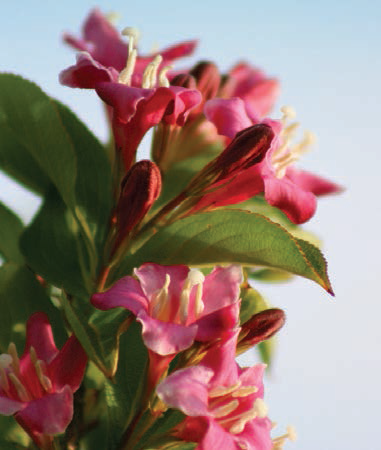Dr. Paul Fitter provides insight into Weigela trials conducted in Ireland, which started in 2008 but which were never completed due to the untimely death of Jim Kelleher (Kildalton College)
The Eurotrial group consists of participants from several European countries: Austria, The Netherlands, France, Germany, England, Finland and now also Ireland. The aim of this group is to test cultivars of a particular plant species under different climatic regimes. The same cultivars are tested in all countries. Plant species tested so far are Buddleia, Vinca, Hydrangea paniculata and Weigela. This research is similar to the Royal Horticultural Society (RHS) Award of Garden Merit (AGM) trials in the UK, but with a broader climatic range. Research like this is useful as varieties other than the ones that have been awarded an AGM in the UK could shine out in countries with a different climate like Finland. Ireland is a welcome participant in this group as it has a mild and wet climate and represents the western limit of the European Union.
WEIGELA TRIAL RESULTS IRELAND
However, the cultivars were planted up in the trial field at Pat FitzGerald’s nursery in Co Kilkenny but were never assessed for their quality under Irish climatic conditions. Pat kept the plants going and there were clear differences in quality between the cultivars, and I felt it would be a waste not to share some of these findings with the industry. Table 1 shows the cultivars used and the overall ratings from five countries.
In Ireland, the results are based on the observations over several years by Pat FitzGerald only, while in the other countries they are based on review panels of up to 15 people. Nevertheless, the results show that what is a very good cultivar in one country does not necessarily make it a good one in another.
Table 1: Weigela Eurotrial overall results of The Netherlands (Nl), Germany (Ge), France (Fr), Austria (Au) and Ireland (Ie). The Dutch results are from non-Eurotrial Weigela tests, and hence some results are missing. The Irish results are not by panel assessment.





Most variegated cultivars grew well, with ‘Kosteriana Variegata’ and ‘Brigela’ (also yellow leaved) performing best. Of the miniature cultivars ‘Little Red Robin’ stood out with fresh green foliage and contrasting bright red flowers. This cultivar also responded very well to cutting back hard.
In the dark foliaged cultivars, ‘Alexandra’ and ‘Verweig 3’ stood out, while some other cultivars either died or performed very badly. It is interesting to note that ‘Naomi Campbell’ got very high marks in the Netherlands and Austria, while it died in Kilkenny.
WHAT NEXT?
The agreement was reached in 2011 for the current trial on Hibiscus. In winter 2012, 60 cultivars of Hibiscus syriacus were propagated (grafted) by Minier Nurseries in France. They were grown on in the French nursery the following year and sent to the testing stations in February/March 2014.
Per testing station, 60 cultivars were delivered, and three plants of each cultivar were potted up. In Ireland, the plants are being grown at Pat FitzGerald’s nursery in Co Kilkenny. The first observations will be made this year.
Some cultivars are already showing stronger growth than, others, while panel assessments will commence in 2016. The cultivars will be assessed for three to four years in all countries on general performance, flower power, diseases resistance etc. If anyone is interested in getting involved in these assessments, please let me know. (paul.fitters@teagasc.ie). Thanks.
I would like to thank Pat FitzGerald for generously providing space and time for these trials, Bord Bia for financial support, and Teagasc for allowing me to do this research. ✽
  |










